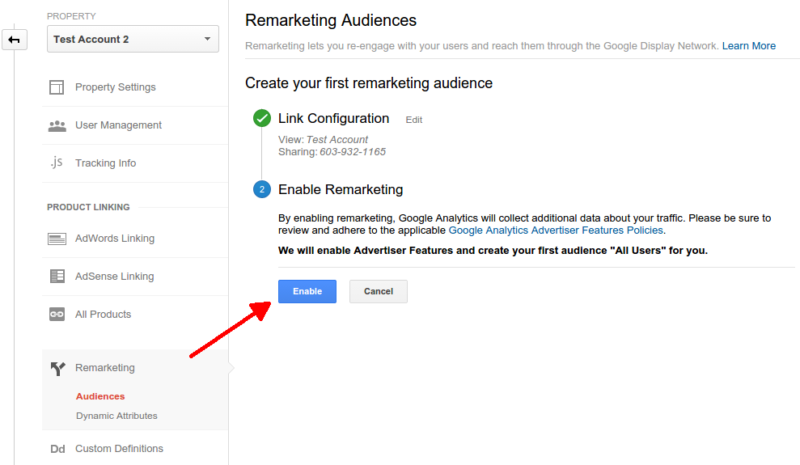Recognizing the Power of Remarketing In Google Analytics
Recognizing the Power of Remarketing In Google Analytics
Blog Article
Harnessing Remarketing in Google Analytics: A Comprehensive Guide
Harnessing remarketing in Google Analytics offers businesses a strategic side in reaching out to possible consumers. This overview will drop light on the crucial steps included in using the complete capacity of remarketing in Google Analytics, leading to improved advertising results.
Recognizing Remarketing in Google Analytics
Remarketing in Google Analytics enables businesses to tactically target users who have formerly engaged with their internet site or mobile application. By leveraging information from Google Analytics, businesses can produce personalized remarketing listings based on user behavior, such as pages checked out, actions taken, or specific goals attained. This powerful device enables organizations to re-engage with users who have revealed passion in their services or products, inevitably boosting the probability of conversion.
Recognizing the different kinds of remarketing techniques is critical for an effective project - What Is “Remarketing” In Google Analytics?. Google Analytics supplies different options, consisting of typical remarketing, vibrant remarketing, and remarketing lists for search advertisements (RLSA) Each type serves an unique purpose and can be customized to meet certain advertising goals
Additionally, evaluating the efficiency of remarketing projects is important for maximizing outcomes. Google Analytics offers valuable insights right into the effectiveness of different remarketing methods, enabling businesses to make data-driven choices and fine-tune their targeting method. By continuously monitoring and adjusting remarketing efforts based upon analytics information, businesses can maximize ROI and drive success in their marketing efforts.
Establishing Remarketing Projects

After establishing up target market checklists, the next step is to link Google Analytics with Google Ads. By linking these 2 systems, companies can effortlessly move audience lists from Google Analytics to Google Advertisements for remarketing purposes. This assimilation enables more exact targeting and far better campaign efficiency.
Once the accounts are connected, companies can create remarketing campaigns in Google Ads utilizing the audience lists previously defined in Google Analytics. These campaigns can be personalized with particular advertisement creatives, messaging, and bidding techniques to effectively re-engage with previous visitors and drive conversions. By adhering to these steps, services can utilize the power of remarketing to boost their marketing initiatives and increase ROI.
Using Audience Segmentation Strategies

Predefined sections in Google Analytics permit you to swiftly assess usual audience categories like brand-new users, returning users, or customers that finished a details objective on your web site. Personalized segments, on the other hand, allow you to develop distinct sections based upon particular standards that are essential to your company goals. Dynamic remarketing listings automatically change based on user behavior, showing personalized ads to users What Is “Remarketing” In Google Analytics? that have interacted with your site specifically methods.
Studying Remarketing Efficiency Metrics
Upon assessing the effectiveness of remarketing campaigns in Google Analytics, the evaluation of essential efficiency metrics provides valuable insights into audience engagement and conversion prices. By diving into metrics such as click-through prices (CTR), conversion rates, expense per purchase (CPA), and return on ad invest (ROAS), marketing experts can evaluate the success of their remarketing efforts. Assessing these metrics enables marketing experts to enhance projects, refine target market targeting, and allocate spending plans efficiently to enhance general remarketing performance.
Optimizing Remarketing Strategies
When refining remarketing methods in Google Analytics, focusing on target market segmentation is vital for attaining campaign success. By separating your audience into certain sections based upon their actions, demographics, or passions, you can customize your ads better to each team. This targeted technique raises the possibility of engaging users that have currently revealed passion in your solutions or items, resulting in greater conversion rates.
Another vital element of enhancing remarketing strategies is continually screening and refining your projects (What Is “Remarketing” In Google Analytics?). A/B testing different advertisement creatives, messaging, or deals can assist you identify what reverberates best with your target market and drives the most conversions. By analyzing the efficiency of these examinations in Google Analytics, you can make data-driven choices to maximize your remarketing initiatives further
Additionally, leveraging his explanation dynamic remarketing can considerably enhance your campaign results. This attribute allows you to show customized advertisements next to customers based upon their previous interactions with your website, showcasing services or products they have formerly checked out. By providing tailored web content to users based upon their actions and passions, vibrant remarketing can aid boost interaction and drive conversions.
Conclusion
In final thought, utilizing remarketing in Google Analytics is a calculated approach to target users that have actually previously engaged with a site. By producing personalized audience checklists and using target market segmentation techniques, businesses can maximize remarketing projects for boosted conversion prices. Examining efficiency metrics and continuously optimizing strategies are critical for maximizing the efficiency of remarketing initiatives.
Google Analytics supplies different choices, consisting of basic remarketing, dynamic remarketing, and remarketing checklists for search advertisements (RLSA)After establishing up audience listings, the following step is to connect Google Analytics with Google Ads. By connecting these 2 systems, companies can effortlessly move audience checklists from Google Analytics to Google Advertisements for remarketing objectives.When the accounts are connected, businesses can produce remarketing campaigns in Google Ads utilizing the audience notes previously defined in Google Analytics.When refining remarketing approaches in Google Analytics, concentrating on target market segmentation is paramount for achieving campaign success.
Report this page